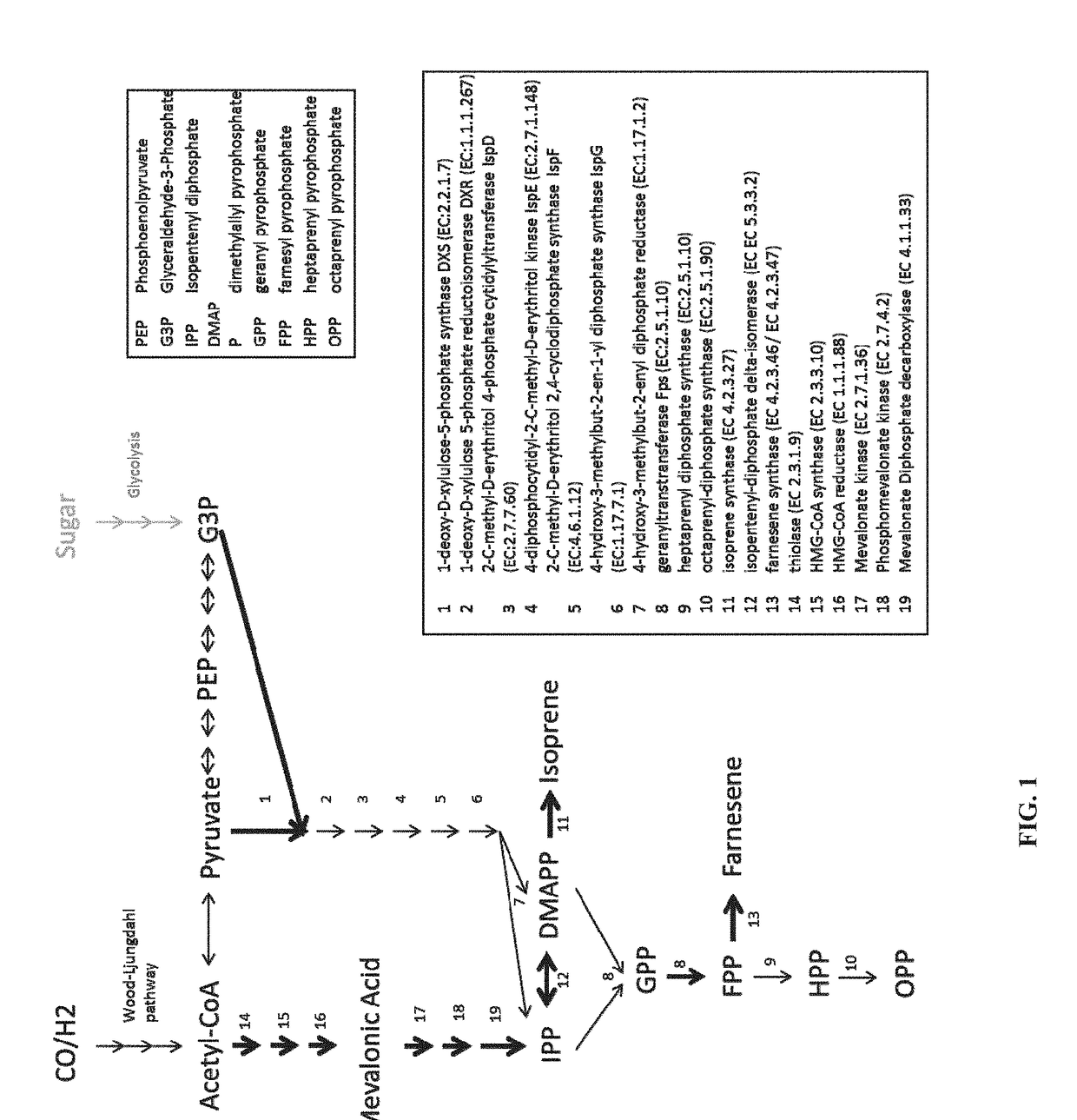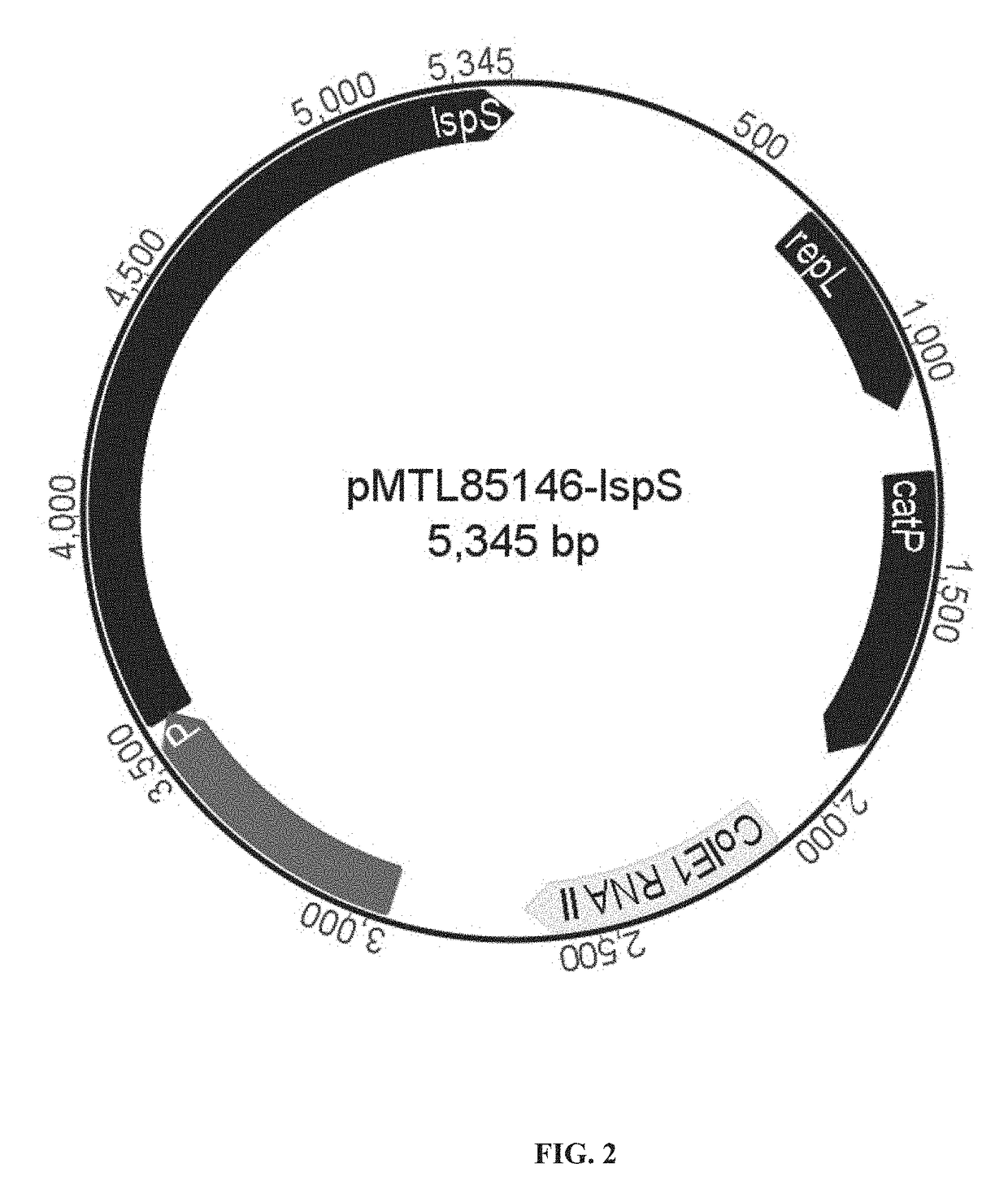Microbial fermentation for the production of terpenes
a technology of terpenes and fermentation, which is applied in the direction of transferases, lyases, carbon-carbon lyases, etc., can solve the problems of not all bacteria comprise the necessary cellular machinery to produce terpenes and/or their precursors, and most bacteria are not known to produce any terpenes, etc., and achieve the effect of increasing the number of copies
- Summary
- Abstract
- Description
- Claims
- Application Information
AI Technical Summary
Benefits of technology
Problems solved by technology
Method used
Image
Examples
example 2
n of Isopentenyl-Diphosphate Delta-Isomerase to Convert Between Key Terpene Precursors DMAPP (Dimethylallyl Diphosphate) and IPP (Isopentenyl Diphosphate)
[0332]Availability and balance of precursors DMAPP (Dimethylallyl diphosphate) and IPP (Isopentenyl diphosphate) is crucial for production of terpenes. While the DXS pathway synthesizes both IPP and DMAPP equally, in the mevalonate pathway the only product is IPP. Production of isoprene requires only the precursor DMAPP to be present in conjunction with an isoprene synthase, while for production of higher terpenes and terpenoids, it is required to have equal amounts of IPP and DMAPP available to produce Geranyl-PP by a geranyltransferase.
Construction of Isopentenyl-Diphosphate Delta-Isomerase Expression Plasmid:
[0333]An Isopentenyl-diphosphate delta-isomerase gene idi from C. beijerinckii (Gene ID:5294264), encoding an Isopentenyl-diphosphate delta-isomerase (YP_001310174.1), was cloned downstream of ispS. The gene was amplified us...
example 3
ssion of DXS Pathway
[0336]To improve flow through the DXS pathway, genes of the pathway were overexpressed. The initial step of the pathway, converting pyruvate and D-glyceraldehyde-3-phosphate (G3P) into deoxyxylulose 5-phosphate (DXP / DXPS / DOXP), is catalyzed by an deoxyxylulose 5-phosphate synthase (DXS).
Construction of DXS Overexpression Expression Plasmid:
[0337]The dxs gene of C. autoethanogenum was amplified from genomic DNA with oligonucleotides Dxs-SalI-F (SEQ ID NO: 29: GCAGTCGACTTTATTAAAGGGATAGATAA) and Dxs-XhoI-R (SEQ ID NO: 30: TGCTCGAGTTAAAATATATGACTTACCTCTG) as described for other genes above. The amplified gene was then cloned into plasmid pMTL85246-ispS-idi with SalI and XhoI to produce plasmid pMTL85246-ispS-idi-dxs (SEQ ID NO: 31 and FIG. 4). DNA sequencing using oligonucleotides given in Table 3 confirmed successful cloning of ispS, idi, and dxs without mutations (FIG. 5). The ispS and idi genes are as described in example 1 and 2 respectively.
TABLE 3Oligonucleotid...
example 4
ion and Expression of Mevalonate Pathway
[0339]The first step of the mevalonate pathway (FIG. 7) is catalyzed by a thiolase that converts two molecules of acetyl-CoA into acetoacetyl-CoA (and HS-CoA). This enzyme has been successfully expressed in carboxydotrophic acetogens Clostridium autoethanogenum and C. ljungdahlii by the same inventors (US patent 2011 / 0236941). Constructs for the remaining genes of the mevalonate pathway have been designed.
Construction of Mevalonate Expression Plasmid:
[0340]Standard recombinant DNA and molecular cloning techniques were used (Sambrook, J., and Russell, D., Molecular cloning: A Laboratory Manual 3rd Ed., Cold Spring Harbour Lab Press, Cold Spring Harbour, N Y, 2001). The three genes required for mevalonate synthesis via the upper part of the mevalonate pathway, i.e., thiolase (thlA / vraB), HMG-CoA synthase (HMGS) and HMG-CoA reductase (HMGR), were codon-optimised as an operon (Pptaack-thlA / vraB-HMGS-Patp-HMGR).
[0341]The Phosphotransacetylase / Aceta...
PUM
 Login to View More
Login to View More Abstract
Description
Claims
Application Information
 Login to View More
Login to View More - R&D
- Intellectual Property
- Life Sciences
- Materials
- Tech Scout
- Unparalleled Data Quality
- Higher Quality Content
- 60% Fewer Hallucinations
Browse by: Latest US Patents, China's latest patents, Technical Efficacy Thesaurus, Application Domain, Technology Topic, Popular Technical Reports.
© 2025 PatSnap. All rights reserved.Legal|Privacy policy|Modern Slavery Act Transparency Statement|Sitemap|About US| Contact US: help@patsnap.com



